Menu

Sustainable farming is a key tool in the fight against climate change. It uses less energy and creates fewer carbon emissions. This is good news for our planet’s future. Yet, making farms sustainable needs big money. This is where government grants come in.
The USDA’s Agricultural Marketing Service offers help with the Organic Market Development Grant programme. With $40.5 million in grants, it boosts organic farming. It helps by growing organic markets, improving processing, and spreading new tech. This supports over 27,000 farmers and 31.8 million buyers. It’s part of a bigger plan to make our food system strong, fair, and eco-friendly. This plan fits in well with the new Biden-Harris leadership.
More and more, governments are backing eco-friendly farming. They offer help like agricultural subsidies and green grants. This money lets farmers try new techniques that are good for the earth and their wallets.
There’s a lot of different grants out there. For example, the USDA helps growers find markets for organics. And there are grants for:
The National Fish and Wildlife Foundation Grants do great work for the environment, too.
Eligibility depends on what you grow and if you handle things organically. It also helps if you’re in need of financial help. For example, special USDA projects support rural growth by helping directly with funds.
The grant applications are detailed. And there are steps to follow, like showing how you’ll share the costs. The goal is to have projects that really push farming for the future.
By following these steps, funding makes a real difference in farming that’s both sustainable and green.
Eco-friendly farming is crucial in today’s agriculture for many reasons. It helps the environment, our wallets, and our communities. More and more people care about the impact food has on our planet. That’s why using sustainable ways of farming is becoming very important.
Eco-friendly farming does wonders for our planet. Integrated Pest Management (IPM) in the U.S. has cut down on pesticide use by 50-90%. And, it doesn’t hurt crop yields. No-till farming reduces soil erosion by up to 95% over traditional methods. This helps keep our soil healthy.
Also, water-saving methods like planting riparian buffer strips can reduce nitrate pollution in water by 50%. This protects our fish and water ecosystems.
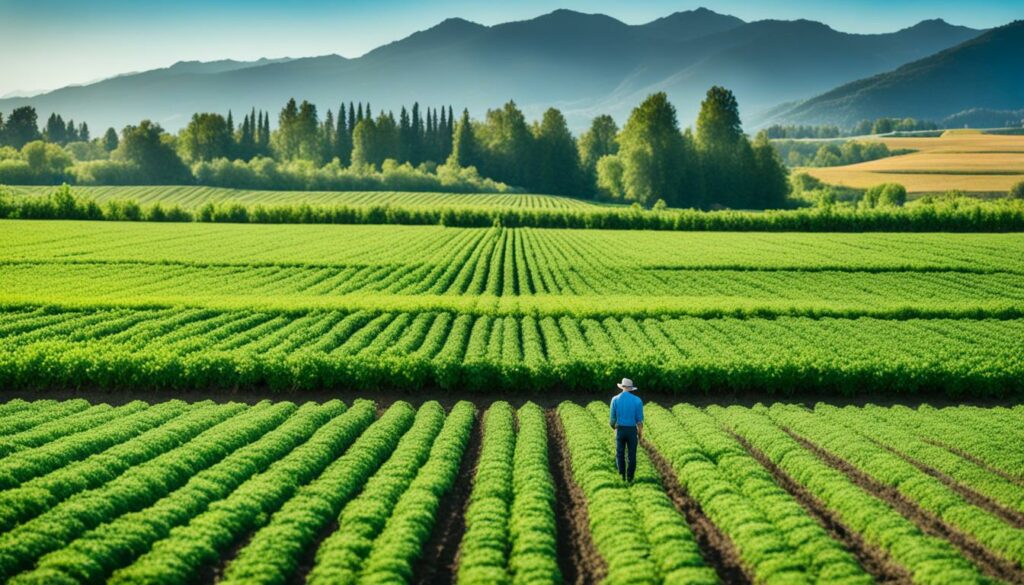
Farming in a green way can also make good financial sense. When farmers rotate where their animals graze, they see more grass grow and up to 400% more carbon stored in the soil. Farms with lots of different crops and animals make about 22% more money than farms growing just one thing.
Managing nutrients well can cut nitrogen leaching by 40-90%. This improves crop growth by 20-35%, making farms more profitable and sustainable.
Eco-friendly farming has big effects on society too. It gets people more involved in their local farming and increases the number of plant and animal species. This makes farming and the environment stronger and better able to face challenges.
Programmes like Sustainable Agriculture Research and Education (SARE) have given over $300 million to support green farming. They help farmers work together for a better food future. In the end, all this means we learn to eat and farm in ways that are better for the planet.
So, using eco-friendly farming is key for moving towards sustainable agriculture. By being smart and creative about it, we can create farming that’s ready for the future. It will be strong, fair, and good for our changing climate.
| Environmental Benefit | Economic Advantage | Social Impact |
|---|---|---|
| 50-90% reduction in pesticide use with IPM | 22% higher returns in diverse systems | Enhanced community engagement |
| 95% reduction in soil erosion with no-till farming | 20-35% increase in crop yields with proper nutrient management | Increased biodiversity |
| 50% reduction in water nitrate contamination | 400% improvement in soil carbon sequestration with rotational grazing | Stronger societal understanding of sustainable food sources |
To make farming more durable and kind to our planet, we must use green methods. These include saving energy, water, and keeping the land safe for the future. It’s crucial for farming to continue thriving.
Integrated pest management (IPM) cuts down on pests’ impact with fewer risks. Ways to keep our land from wearing down include strip cropping and not tilling too much. These methods stop the soil from being washed or blown away by the weather.
Rotational grazing helps keep pastures healthy and cuts down on costs. Cover crops like rye or clover control weeds, keep soil in place, and make it healthier.
Using solar power or wind energy lowers the farm’s climate change effects. With help from grants, farmers can set up solar panels or windmills. These moves are good for the planet and save money over time.
Water control is key to eco-friendly farming. Smart irrigation and planting near rivers help save water. These steps improve water and keep our lands healthy. They also help farmers do better with less water, cutting waste.
Below is a comparison of some key features of sustainable agriculture practices:
| Practice | Benefit | Implementation |
|---|---|---|
| Integrated Pest Management (IPM) | Reduces economic, health, and environmental risks | Combines various tools to manage pests effectively |
| Rotational Grazing | Provides high-quality forage, reduces feed costs, manages manure buildup | Manages grazing patterns and pasture recovery |
| Renewable Energy | Reduces greenhouse gas emissions | Investments in solar panels, wind turbines, etc. |
| Efficient Irrigation | Improves water quality and conserves water resources | Uses advanced irrigation techniques to reduce waste |
The USDA-backed Organic Market Development Grant Program plays a crucial role. It boosts organic markets and promotes the growth of organic farming. This happens across the United States, thanks to its substantial funding.
In the latest funding round, the programme gave out 93 grants. These were spread over three key periods: January, March, and May 2024. January saw 10 grants, March had 60, and May received 23. Together, these grants amounted to over $75 million, supporting many initiatives.
| Distribution Period | Number of Grants | Total Funds Awarded ($) |
|---|---|---|
| January 2024 | 10 | 9,752,858.61 |
| March 2024 | 60 | 40,568,140.40 |
| May 2024 | 23 | 24,863,342.76 |
The grants had different matching fund percentages. One received a full 100% match while another got no match. This shows the programme’s ability to adapt and support various project types.
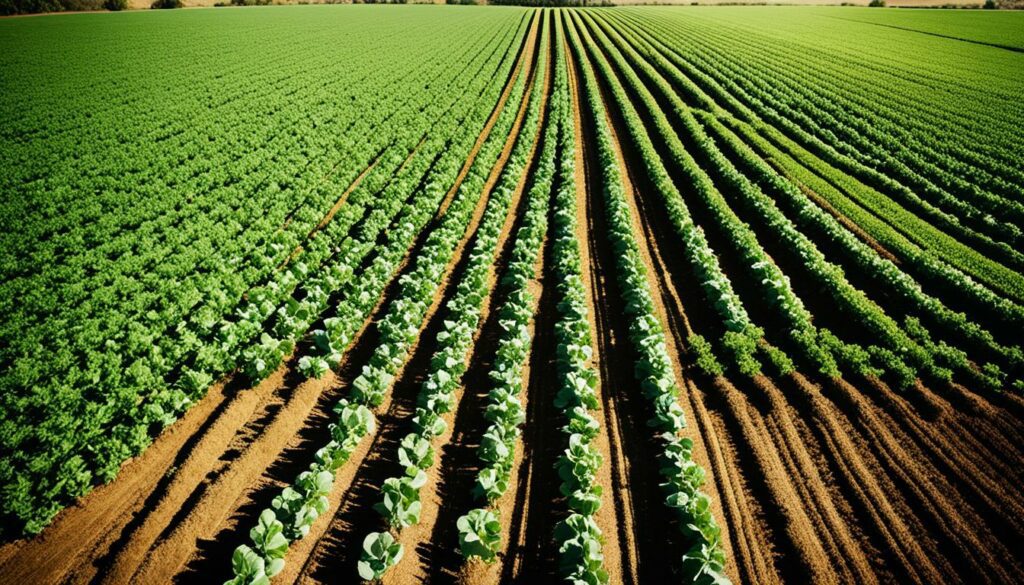
The success stories of the grant include Almar Orchards LLC and the Georgia Organic Peanut Association. They’ve grown their processing capabilities and started new market and educational projects. These efforts have created more jobs and improved the access to organic products. Especially in places like Alabama, Arizona, and California, the impact on the organic supply chain is notable.
Organisations aiming to tap into the USDA’s grant should submit detailed proposals. These proposals must show how their projects align with the programme. It’s important to describe how the funds will be used to better the organic market and consider climate change.
For market development and some processing projects, a 50% non-federal match is necessary. But, if the projects are about easy equipment, no match is needed.
When applying, consider elements like your location, project size, and support for underserved farmers. The USDA favours applications that improve worker safety and wellbeing. If your proposal is accepted, you should carry out the project between 2023 and 2026 to help grow the organic sector sustainably.
Examples like Almar Orchards LLC, the Georgia Organic Peanut Association, and Big Sandy Organics show the power of eco-friendly farming. They highlight how government grants and green farming push have helped both locally and nationally.
In Michigan, Almar Orchards LLC stands out with its organic apples. They have grown thanks to green initiatives and USDA grants. Their use of high-tech farming and sustainable methods increased both their yield and quality.
In Georgia, the Organic Peanut Association has made a big impact. With the help of government grants, they spread their organic peanuts further. This not only grew their production but also benefitted the local economy and community growth.
Big Sandy Organics in Montana focuses on organic snack goods. They have used national and local grants to expand. Their updated processes and marketing have increased their value, all while being eco-friendly.
The Farm Bill plays a key role in shaping sustainable agriculture in America. It covers twelve areas to do with farming and rural life. It includes support for renewable energy, financial help, and efforts to look after the land. This all aims to make farming greener across the country.
The Farm Bill includes measures to boost renewable energy systems. It helps farmers grow energy crops like biofuels. By doing this, it cuts down on using fossil fuels and helps to reduce pollution. It moves farming towards more eco-friendly and sustainable methods.
Through the Farm Bill, farmers can get support to go green. It offers money for eco-friendly farming and projects to save natural resources. The Bill plans to spend a lot, about $428 billion over five years. This helps farmers make their practices more sustainable and environmentally friendly.
The Farm Bill also does a lot to protect the land and wildlife. It spends $6 billion a year on projects to improve soil, protect habitats, and keep open spaces. Important plans like the Regional Conservation Partnership Program and the Conservation Easement Program bring together many groups. They help make sure private land is used in a way that’s good for the planet.
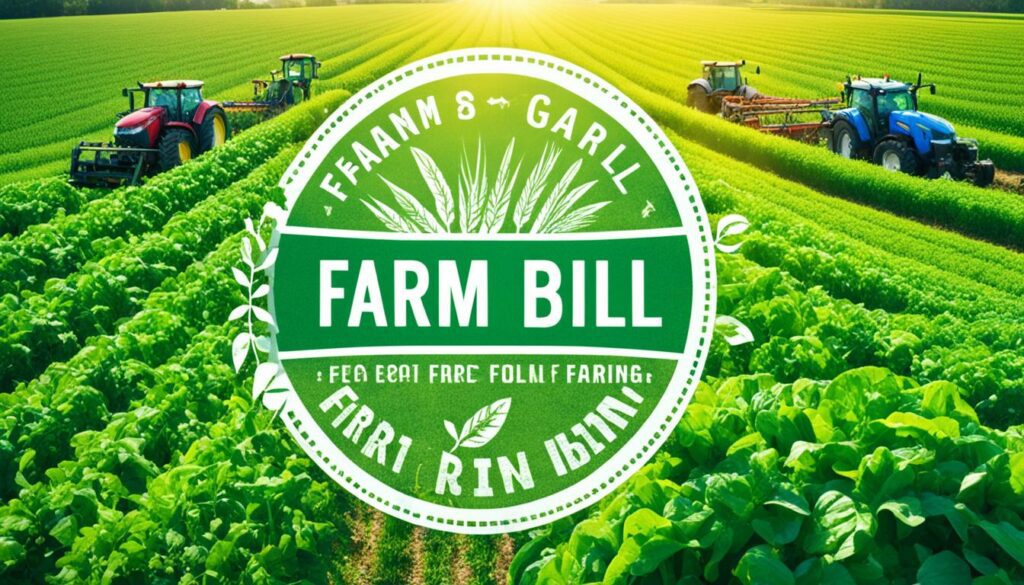
The Farm Bill helps farmers keep their land healthy and fights climate issues. It aims to lower farming’s pollution, which is a big part of the country’s overall emissions. So, the Farm Bill is not just about money. It shows a way to farm that is good for the planet and for farmers’ wallets.
| Aspect | Funding/Description |
|---|---|
| Titles Covered | Twelve, addressing different aspects of agriculture and rural development |
| Total Projected Cost | $428 billion over five years |
| Conservation Funding | $6 billion annually |
| Programs Benefitting | RCPP, ACEP, Local Agriculture Market Program, Organic Agriculture Research |
| Commodities Title | Price and income support for crops like corn, soybeans, wheat, etc. |
The Conservation Innovation Grants (CIGs) programme is a major part of the Environmental Quality Incentives Program. It helps fund sustainable agriculture and has $65 million available from the USDA’s NRCS for FY 2023. Of this, $50 million goes to CIG On-Farm Trials and $15 million to CIG Classic.
To get a CIG project, you need to match 50% of the grant with non-federal money, either as cash or in-kind. They also strive to be inclusive, with up to 10% set aside for projects helping Historically Underserved (HU) farmers and ranchers. Projects can get between $250,000 and $2 million and last from one to three years. The deadline to apply for FY 2023 is October 30, 2023.
On-Farm Trials get a lot of attention. They can win between $250,000 and $5,000,000 for projects that last from three to five years. For FY 2023, over 10% of the funds will help Historically Underserved applicants without needing to match the funds. These projects cover important topics like reducing enteric methane, improving feeding practices, and conserving habitats.
The grants push for innovative conservation on farms and help spread new technologies in conservation. Since 2004, more than 730 projects have helped improve sustainable agriculture in the U.S. Past projects have helped non-English-speaking poultry farmers, shown how cover crops can be used, and created tools to track on-farm energy use.
These grants are a big deal in funding sustainable farming. They help support projects that are key to environmental practices and put new conservation methods into action. They are incredibly important for farmers looking to build sustainable, strong agriculture systems.
Here’s a detailed breakdown on Conservation Innovation Grants:
| Funding Category | Amount Available | Project Duration | Funding Range | Target Audience |
|---|---|---|---|---|
| CIG On Farm Trials | $50 million | 3-5 years | $250,000 to $5,000,000 | General Farmers |
| CIG Classic | $15 million | 1-3 years | $250,000 to $2 million | General Farmers |
| Historically Underserved (HU) | 10% of national CIG funds | 1-5 years | N/A | HU Farmers/Ranchers |
The Common Agricultural Policy (CAP) is vital for making farming better in Europe. It has a huge budget of €387 billion for the years 2021-2027. This money is to help farms produce more in a way that’s good for the planet.
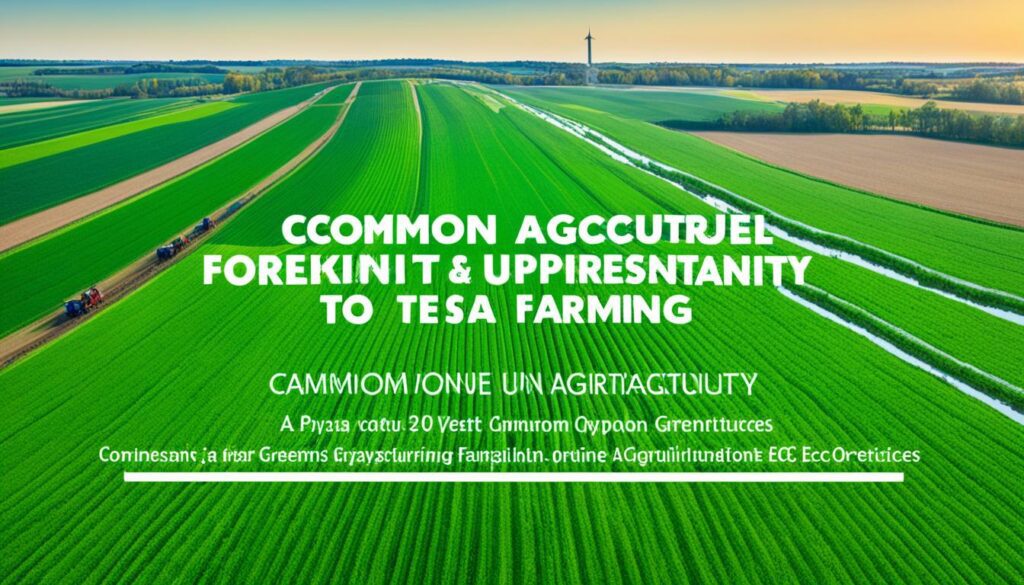
The CAP mainly gets its money from two funds. The European Agricultural Guarantee Fund (EAGF) has €291.1 billion. The European Agricultural Fund for Rural Development (EAFRD) has another €95.5 billion. Also, €8 billion from the Next Generation EU project is there to help rural areas go green and digital.
The CAP rewards farmers who choose eco-friendly ways to farm. It lets countries move up to 25% of their support money from one program to another. Plus, €10 billion is set aside for projects that help farms, rural areas, and the environment in Horizon Europe.
Farmers can get help through the CAP to make their farms greener. The help comes in the form of money or loans. This financial support aids in starting or expanding farms in a sustainable manner.
The CAP doesn’t just give out money. It encourages taking good care of the environment and growing rural businesses too. This helps keep Europe’s farms diverse and ensures a strong future for farming.
Green farming initiatives have many key benefits for our future. These are important for the environment, our wallets, and our way of life.
Green farming helps farms be more energy efficient. For example, using IPM and rotational grazing means less need for harmful chemicals. This makes farming use less energy, which is good for the earth and farm costs.
Farming the green way cuts down on harmful carbon emissions. Practices like no-till farming and cover crops store carbon in the soil. This lowers the amount of carbon in the air. Also, managing nutrients well reduces the release of strong greenhouse gases. It’s a win for the planet.
Green farming also helps protect the world’s variety of life. By having various crops and trees, it makes homes for wildlife. These methods help keep nature in balance and support different plants and animals. Improving water and wetlands also keeps ecosystems healthy and preserves natural homes.
To sum up, going green in farming is a big win. It cuts energy use, reduces carbon emissions, and helps keep our planet full of life. These actions are steps towards a strong, nature-friendly farm future.
Moving to eco-friendly farming is not easy. There are several barriers farmers face. These include high costs, market ups and downs, and the need for help with new methods. Overcoming these hurdles is key to making the switch to green farming easier.
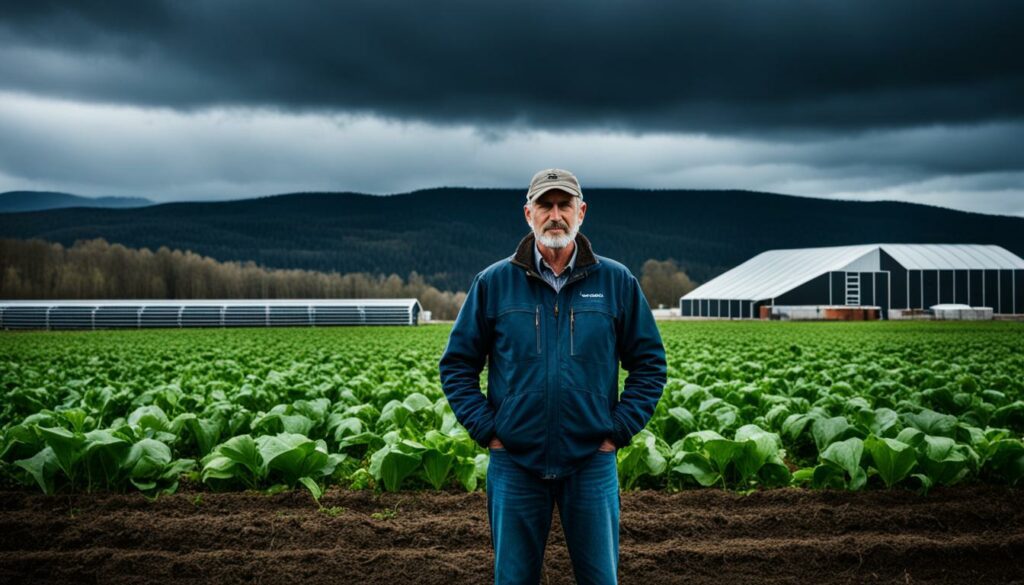
Going green in farming can be pricey at first. While it pays off in the end by needing less costly chemicals and boosting produce, it’s hard for many farmers. The Organic Transition Initiative (OTI) is helping out with $300 million for advice. Yet, going sustainable still costs a lot.
It’s tough to predict if eco-friendly goods will always sell well. Their success can change because of market swings. Even with an initial $9.75 million from the Organic Market Development Grant (OMDG) to improve sales, farmers worry about the future. They fear if they switch, their farm’s product might not be in demand.
When it comes to sustainable farming, technical support is essential for growers. Many farmers don’t know how to use these methods and need detailed help. The Transition to Organic Partnership Program (TOPP) supports them by linking them with experts. It has a five-year plan with good results shown on the USDA website. But, we need even more help to encourage a bigger move towards eco-farming.
The hurdles in switching to eco-friendly farming, like the big setup costs, market uncertainty, and technical help needs, are many. To push forward in greening farming, we must tackle these problems with better funding, helpful incentives, and stronger support systems.
| Initiative | Investment | Purpose | Details |
|---|---|---|---|
| OTI | $300 million | Technical assistance | Helps farmers lower the risk of going organic. |
| OMDG | $9.75 million | Market development | Given to ten projects to grow the organic market. |
| TOPP | N/A (Mentorship program) | Farmer mentorship | Supports farmers in learning about organic farming from expert leads. |
Looking ahead, sustainable agriculture faces some key trends. Technology, a growing consumer desire for organic goods, and forward-thinking agricultural policies will play vital roles. These trends will significantly impact how we farm sustainably in the future.
Future farming will heavily rely on technology. Precision agriculture, using GPS and sensors, reduces waste and harm to the environment. AI and robotics boost efficiency, controlling planting, irrigation, and pest control more precisely.
For soil health, regenerative agriculture uses cover crops and rotating grazing. Agroforestry ventures add trees to farms to better the soil and reduce carbon in the air.
More and more people want to buy organic. This trend has many benefits, like less water pollution and better ecosystems. The demand helps spread more eco-friendly practices among farmers.
Organic methods benefit soil and water, which is good for everyone’s health. This change also eases worries about public health and food production.
Setting new rules in agriculture is key to making a greener future. Governments are giving rewards to farmers who go green. These rewards include money and tax benefits to encourage eco-friendly practices.
New laws focus on cutting carbon and preserving nature. Financial aid eases the costs of changing to eco-farming. This helps farmers financially in the long run.
Global organisations and researchers are also pitching in. They share info and technologies for farming sustinably worldwide.
As policies develop, they’re shaping a more stable, eco-friendly farming sector.
To get the most out of government grants for eco-friendly farming, a smart plan is needed. It involves focusing on the right grants, teaming up with other farmers, and making the best use of what’s around you. Doing this can boost your chances of getting the money you need.
Choosing the grants that best fit your farm is key to success. Look at what the Agriculture and Food Research Initiative or Sustainable Agriculture Research and Education (SARE) group are looking for. Integrated Pest Management (IPM) grants, for instance, help to lessen risks to the economy and the environment. By applying for grants that match your goals, you up your odds of winning.
Teaming up with others can make your grant application stronger. Working with nearby farms or groups shows you have more resources and expertise together. For example, using rotational grazing not only cuts costs but also highlights a shared approach to managing resources. Together, you can make a stronger case for the grant.
Using all the help you can get is vital when trying to win grants. This includes getting advice, educational tools, and tapping into local networks. Practices like strip cropping and planting to save water show you can wisely use resources. These methods also boost your farm’s sustainability.
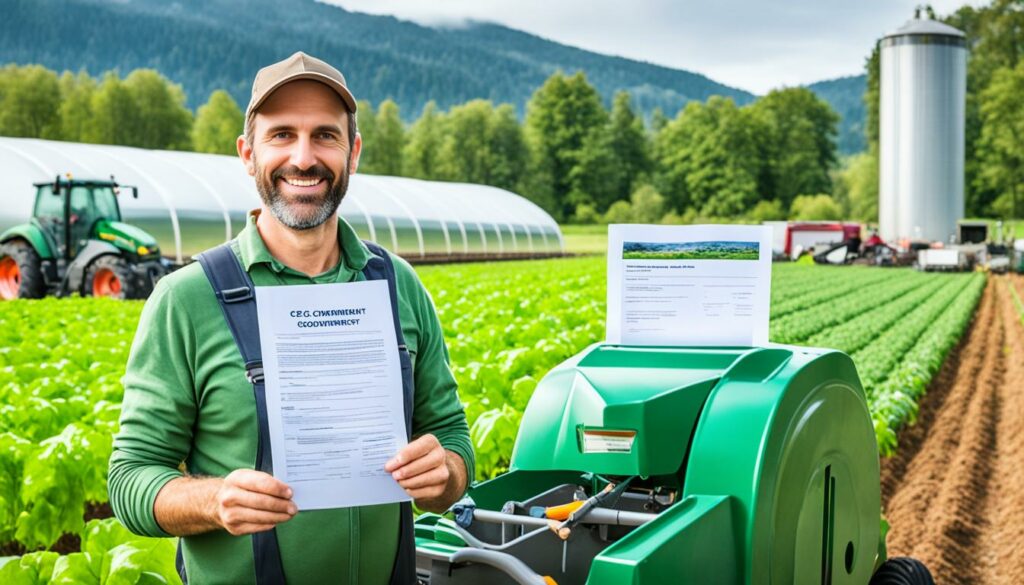
Cover crops such as rye and clover are great for controlling weeds and keeping the soil healthy. Combining tree planting with your crops, known as agroforestry, indicates a commitment to using resources well. Selling directly at local markets or through CSA schemes highlights your farm’s smart business practices.
By choosing the right grants, working with others, and smartly using resources, farmers can make the most of what’s offered. These strategies not only improve your chances of getting grants but push for farming that’s good for the earth and your pocket too.
Leveraging environmental grants is vital for sustainable agriculture. The Sustainable Farming Incentive (SFI) offers between £10 and £732 per hectare. Additionally, the Countryside Stewardship (CS) and the Farming Equipment and Technology Fund (FETF) provide up to £50,000. These grants help farmers adopt new technologies, increase productivity, and aid in environmental protection.
The range of funding available is vast. Water Management grants and Water Restoration Fund awards contribute to sustainable water use. The Species Survival Fund supports biodiversity conservation. These financial aids are crucial for sustainable agriculture, making it more resilient and eco-friendly.
Understanding government subsidies is also key. The European CAP aims to stop unsustainable practices, but its efficiency is debated. Chinese funding focuses on the environment. There’s dispute over whether rich nations’ subsidies help or worsen poverty. This shows the need for better policy and research to improve support programs.
Success relies on farmers and government working together. By wisely using these grants, they can achieve both short-term environmental goals and long-term economic and social gains. This teamwork ensures a brighter, greener future for farming.
There are many grants available for sustainable farming, like those from the Conservation Innovation Grants (CIGs). Also, the Organic Market Development Grant program and some from the EU’s Common Agricultural Policy (CAP). These grants focus on organic farming and supporting new ideas for the environment.
To apply for a grant, look at what you’re farming, like organic grains. You might need special certifications too. Your project should help the environment. And make sure you follow the government’s rules. They often want you to share some of the costs.
You’ll need to write a detailed project proposal. Explain how you’ll use the money for green farming. Make sure your plan fits the grant’s goals.
Green farming uses less energy and cuts down on pollution. It’s good for the soil, plants, and water. By rotating crops and using less machinery, it helps keep the land healthy.
Sustainable farming can be good for business in the long run. It creates jobs and makes the market more reliable. Plus, it meets the growing demand for organic and green products.
It gets communities working together and protects local wildlife. It helps people learn where their food comes from and how to eat and live more responsibly.
It’s important to rotate crops, use less heavy machinery, and protect wild areas. These things keep the soil rich, save water, and help local plants and animals thrive.
Solar and wind power don’t pollute and cut energy bills. These clean energy sources are good for the future of farming. Governments often help farmers pay for them.
Smart irrigation and saving water are key. They lessen the need for fresh water and make water use better. This is vital for a green farm.
This USDA program boosts organic markets. It helps with product processing and introduces new tech. Its aim is to help thousands of producers and millions of consumers with organic food.
Almar Orchards LLC and the Georgia Organic Peanut Association are great examples. They’ve used grants to grow their business. They’ve focused on new methods and have gained organic certifications.
The Farm Bill helps by funding green energy, offering financial help, and guiding conservation. It supports making biofuels from crops, gives tax breaks for eco farming, and cares for the land and water.
These grants, under the EQIP, back new, green ideas in farming. Since 2004, they’ve funded over 730 projects. They aim to make farming better for the environment.
The CAP gives money and rewards for thinking green in the EU. It offers grants and loans to start or improve eco farming. It looks for ways to help nature and the economy in the countryside.
Using the latest farming and energy saving techniques means using less power. This makes farming not just cleaner but also more efficient, saving money and energy.
Getting started can be costly, and the market can be up and down. Farmers may need help learning new ways to farm sustainably. It’s important to overcome these hurdles to make green farming mainstream.
Farming that’s smart and green will grow with new tech and more people wanting organic. New laws will also help make farming more sustainable, protecting the environment and supporting a healthier planet.
**Choosing the right grants and working with others can make your project more appealing. Sharing ideas and resources with fellow farmers helps too. Also, look for help in understanding what each grant needs.